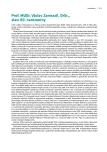-
Medical journals
- Career
Iodine supply and iodinuria among the Czech population between the years 1995 and 2016
Authors: Lydie Ryšavá 1; Jaroslav Kříž 2; Lucie Kašparová 1; Tereza Křížová 1; Monika Žoltá 1; Petra Lisníková 1
Authors‘ workplace: Státní zdravotní ústav, Praha 1; Společnost hygieny a komunitní medicíny České lékařské společnosti J. E. Purkyně, Praha 2
Published in: Vnitř Lék 2016; 62(Suppl 3): 28-32
Category: Original Contributions
Overview
Monitoring of Ioduria and Iodine saturation are essential tools for evaluation of effectivness of measures aimed at elimination of diseases caused by iodine deficiency. Between 1995 and 2016 monitoring of ioduria was udertaken in various population groups in Czech Republic. The most recent study (2015) found only 37 % of pregnant women in optimal range of ioduria (150–300 mcg/l), in iodopenic range 27 %, while 6 % of these had severe iodopenia below 50 mcg/l. In a group of 3y old children investigated in the same year, 57 % were found to have Ioduria within the recommended range (90–299 mcg/l), 24 % had higher than recommended Ioduria (300–499 mcg/l) and 8 % excessive saturation (over 500 mcg/l). Observed group of seniors (60–75 years) satisfied criteria for maintenance of elimination of iodine deficit of International Council for Control of Iodine Deficiency Disorders (ICCIDD), the advisory institution to World Health Organisation (WHO), as only 9 % of participants were found to have Ioduria less than 100 mcg/l and no participant had Ioduria below 50 mcg/l. Main challenges are currently stabilisation of Iodine content in milk and ensuring optimal saturation of pregnant and breast feeding women with Iodine. On-going ambition of the Inter-resort Commission for Solution of Iodine Deficit (MKJD) affiliated to the National Health Institute in Prague is to reduce and eventually eliminate diseases caused by Iodine deficiency or excess. Also, to achieve Ioduria between 100–300 mcg/l in majority of population, which would indicate adequate Iodine supply, while median of Iodurias should remain below 300 mcg/l.
Key words:
iodine deficiency – iodine supply – ioduria
Sources
1. Drápal J, Hajšlová J, Jechová M et al. Informace vědeckého výboru pro potraviny. SZÚ: VVP: INFO/2006/18/deklas/JOD/1. Dostupné z WWW: http://czvp.szu.cz/vedvybor/dokumenty/vvpdokumenty.htm.
2. WHO, UNICEF, ICC IDD. Assessment of iodine deficiency disorders and monitoring their elimination: a guide for programme managers. 3rd ed. WHO Press: Geneva 2007. ISBN 978–92–4-159582–7.
3. Zimmermann M, Ito Y, Hess S et al. High thyroid volume in children with excess dietary iodine intakes. Am J Clin Nutr 2005; 81(4): 840–844. Erratum in Am J Clin Nutr 2005; 82(1): 203.
Labels
Diabetology Endocrinology Internal medicine
Article was published inInternal Medicine

2016 Issue Suppl 3-
All articles in this issue
- Iodine supply of pregnant women in the Czech Republic
- Thyroid cancer in children and adolescents and its molecular genetic background
- Endocrine complications of modern cancer therapy
- Levothyroxine therapy – factors influencing its outcome
- Endocrine orbitopathy – the topic still alive
- Are the thyroid hormones and thyrotropin associated with cardiometabolic risks and insulin resistance even in euthyroid subjects?
- Current and future therapy of acromegaly
- Cardiorenal syndrome – biomarkers and mediators
- TSH secreting adenomas
- Central Thyroid Disorders
- Vitamin D and Polycystic Ovary Syndrome
- Thyroid hormones and cardiovascular system
- The endocannabinoid system and bone
-
Solution of Iodine deficiency in the Czech Republic – history and current situation
20 years of work of prof. Václav Zamrazil for Commission for the solution of Iodine deficiency - Psycho-immuno-endocrinology of the thyroid gland
- Thyroid carcinomas – current therapeutic procedures
- Vitamin D and autoimmune thyroid diseases
- Testosterone and mortality
- Congenital Adrenal Hyperplasia in Adults
- Polypharmacy viewed not only through the prism of multi-morbidity, but also as an independent geriatric syndrome
- Multiple Endocrine Neoplasia I (Wermer‘s Syndrome), Forms of Clinical Manifestation, 5 Case Studies
- The course of differentiated thyroid microcarcinoma in patients treated by different therapeutic strategies
- The SPACE project (Stav Pacientů Akceptovaných diabetologem Cestou Exportu/The Health Records of Patients Accepted by a Diabetologist by way of Export)
- Iodine supply and iodinuria among the Czech population between the years 1995 and 2016
- Urinary iodine concentration in adult patients with type 1 diabetes mellitus
- Internal Medicine
- Journal archive
- Current issue
- Online only
- About the journal
Most read in this issue- Congenital Adrenal Hyperplasia in Adults
- Multiple Endocrine Neoplasia I (Wermer‘s Syndrome), Forms of Clinical Manifestation, 5 Case Studies
- Vitamin D and autoimmune thyroid diseases
- Central Thyroid Disorders
Login#ADS_BOTTOM_SCRIPTS#Forgotten passwordEnter the email address that you registered with. We will send you instructions on how to set a new password.
- Career

